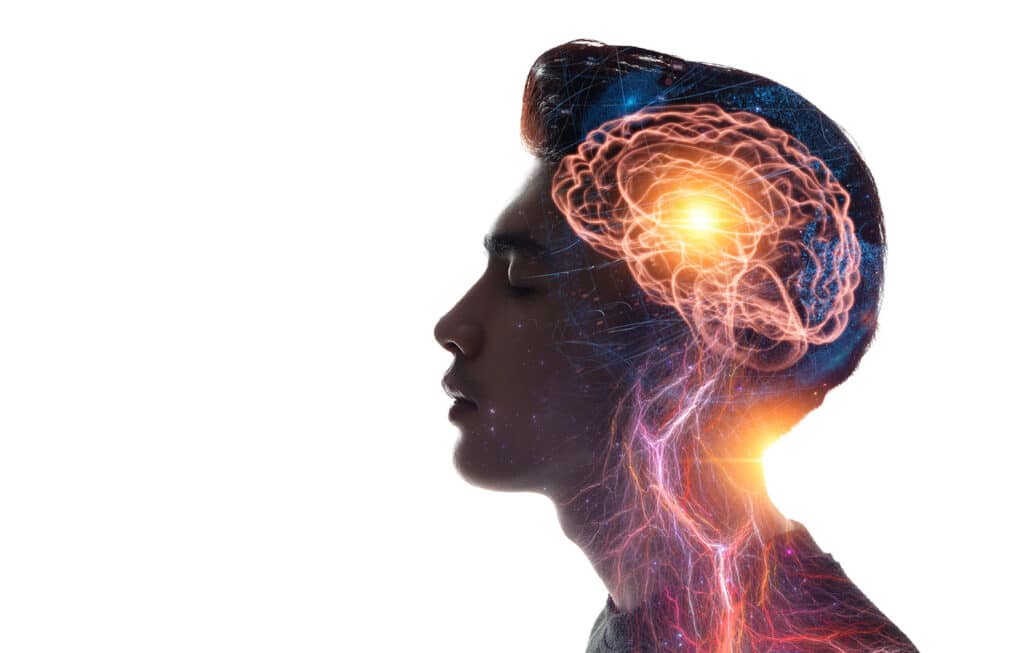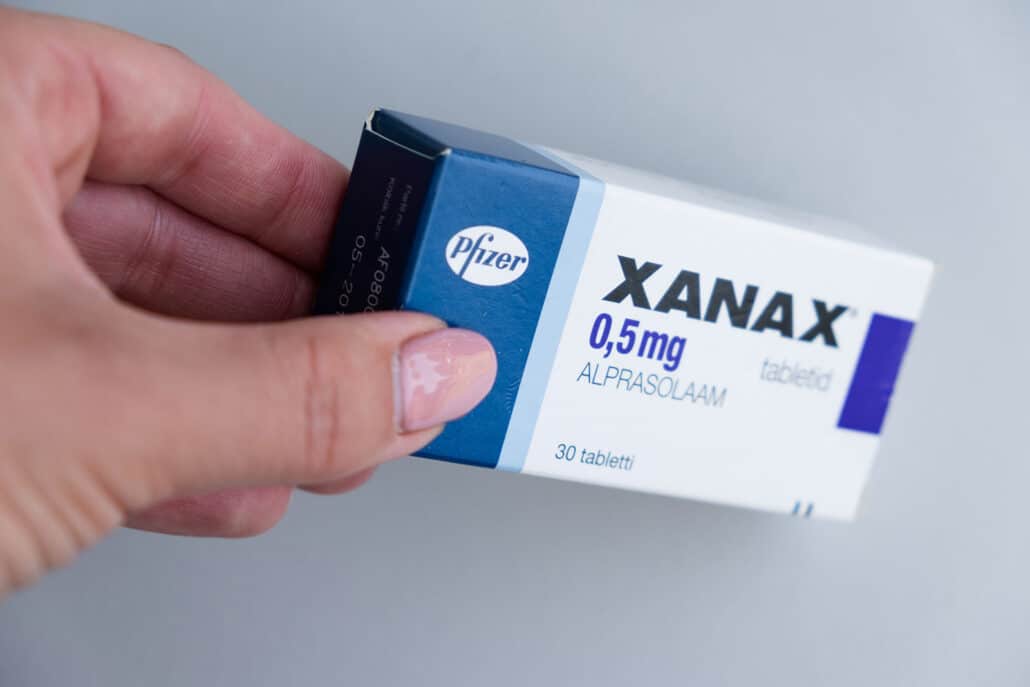Xanax, known generically as alprazolam, is a prescription benzodiazepine (“benzo”) commonly prescribed to manage anxiety disorders and panic disorders. Its ability to effectively provide calming effects makes it a popular choice for people seeking relief from intense anxiety. However, when taking this medication, understanding how long Xanax affects the brain is crucial, especially considering the drug’s potential for misuse and dependency. In this article, we’ll take a deep look at the duration of Xanax’s impact on the brain, the medication’s effects, and the importance of seeking professional help for anyone struggling with Xanax addiction or withdrawal.
Table of Contents
How Xanax Works in the Brain
Xanax works by enhancing the activity of gamma-aminobutyric acid (GABA), a neurotransmitter that inhibits nerve activity in the central nervous system. By binding to the GABA receptors, Xanax increases GABA’s calming effects, which helps to significantly reduce anxiety and promote relaxation. This mechanism not only alleviates anxiety symptoms, but it also produces a sedating effect, making Xanax an effective option for managing panic attacks and severe anxiety episodes.

The immediate effects of the drug typically last between four to six hours after ingestion. During this period, individuals may experience a noticeable reduction in anxiety and an overall sense of calm. However, the duration of Xanax’s impact can vary based on several factors, including the dosage, the frequency of use, the individual’s metabolism, and their overall health. The half-life of Xanax can also play a role in how long it affects the brain.
Short-Term Effects on the Brain
In the short term, Xanax provides temporary relief from anxiety and panic symptoms, making it easier for the person to relax and deal with stressful situations. However, alongside these beneficial effects, Xanax can also produce several side effects of Xanax that impact the brain and the user’s overall cognitive function.
Listed below are some of the most common short-term effects of Xanax:
- Sedation and Drowsiness: Many users experience significant drowsiness, which can impair their ability to perform tasks that require alertness, such as driving or operating machinery.
- Cognitive Slowing: Xanax can cause a temporary slowdown in cognitive processes, affecting memory loss, concentration, and decision-making abilities.
- Dizziness and Lightheadedness: These sensations are common and can increase the risk of falls or accidents, especially in older adults.
Long-Term Effects of Xanax on the Brain
Prolonged use of benzodiazepines like Xanax can lead to more severe and lasting effects on the brain and the individual’s overall mental health. Taking Xanax for a prolonged period can alter the brain’s neurochemistry, which can result in increased tolerance, physical dependence, and a variety of cognitive and emotional issues.
Listed below are some of the most common long-term effects of Xanax:
- Tolerance and Dependence: Over time, the brain may require higher doses of Xanax to achieve the same calming effects, leading to tolerance. Dependence occurs when the brain adapts to the presence of Xanax in the system, making it difficult to function normally without the medication.
- Withdrawal Symptoms: Stopping Xanax abruptly after long-term use can trigger withdrawal symptoms, including severe anxiety, insomnia, seizures, and hallucinations. These symptoms make it challenging to discontinue the medication without professional assistance.
- Memory Problems: Regular use of Xanax can impair both short-term and long-term memory, making it difficult to retain new information or recall past events.
- Cognitive Impairment: Prolonged use of Xanax can lead to persistent issues with attention, concentration, and decision-making, which can greatly affect a person’s daily functioning and productivity.
- Emotional Regulation Challenges: Taking Xanax long-term can disrupt the brain’s ability to regulate emotions, leading to increased irritability, mood swings, and a higher risk of depression.
These long-term effects of Xanax use illustrate the importance of careful monitoring and management when taking the medication for extended periods.
Factors That Influence How Long Xanax Affects the Brain
Several factors can influence the duration and intensity of Xanax’s effects on the brain. Understanding these factors can help individuals and healthcare professionals make informed decisions about Xanax use and manage its impact more effectively for each individual.
- Dosage and Frequency of Use: Higher doses and more frequent use of Xanax will typically extend its longer-term effects and increase the risk of developing tolerance and dependence. On the other hand, if you’re taking a relatively low dose, the medication’s impact on the brain likely won’t last as long.
- The Individual’s Metabolism: Different people metabolize medications at different rates based on their genetic makeup, age, liver function, and overall health. People with faster metabolisms will generally process Xanax more quickly, reducing the duration of its effects, while having a slower metabolism may prolong its impact.
- Use of Other Substances: Using Xanax in combination with other substances, such as alcohol or opioids, can intensify the drug’s effects and increase the risk of adverse reactions, including respiratory depression and Xanax overdose.

Benefits of Professional Help in Managing Xanax Use
When dealing with Xanax dependency or misuse, seeking professional help is crucial. Healthcare providers can offer comprehensive support and treatment options tailored to your specific needs, ensuring a safe and effective recovery process.
Seeking professional help to manage your Xanax use can offer all of the following benefits:
- Medical Detox: Undergoing detox from a medication like Xanax in a supervised environment will ensure that all withdrawal symptoms are managed safely and effectively, which will make the process more comfortable and greatly reduce the risk of complications.
- Therapeutic Support: Counseling and behavioral therapies, such as cognitive behavioral therapy (CBT), help address the psychological aspects of addiction, promoting long-term recovery and emotional well-being.
- Medication Management: Healthcare professionals can provide medications to alleviate withdrawal symptoms and reduce cravings, making the transition to sobriety more manageable and more likely to be successful.
- Personalized Treatment Plans: Professional treatment centers like Long Island Interventions offer customized recovery programs, which are tailored to the unique needs of the individual. These treatment plans address both the physical and emotional aspects of addiction.
How Long Island Interventions Can Help
Long Island Interventions is dedicated to providing comprehensive support and resources for individuals struggling with substance abuse, including Xanax abuse and dependency. Our team of experienced professionals understands the complexities and unique challenges of addiction and is committed to guiding individuals through every step of their recovery journeys.
At our recovery center, we conduct thorough assessments to understand each patient’s unique needs, challenges, and goals, ensuring that the treatment plan is tailored specifically to them. Our trained professionals then design comprehensive addiction treatment programs, which integrate medical detox, counseling, behavioral therapies, and support groups to thoroughly address both the physical and psychological aspects of addiction. We offer both inpatient and outpatient programs to meet individual needs.
At Long Island Interventions, we believe in treating the whole person, not just the addiction. In addition to things like supervised detox and medication management, our holistic approach includes wellness activities, nutritional support, and mental health services to promote overall well-being. This combination of treatments provides each individual with the tools, knowledge, and support that they need to be successful in their recovery journey.
Conclusion
Understanding how long Xanax affects the brain is essential for anyone considering taking the medication or currently struggling with dependency. While Xanax can provide immediate relief from anxiety and panic symptoms, its impact on the brain can extend far beyond the initial effects, leading to tolerance, dependence, and significant cognitive and emotional challenges. This is especially true when it comes to prolonged, regular use of the drug.
At Long Island Interventions, we are committed to supporting individuals through every step of their recovery journey. Our comprehensive detox programs, team of compassionate medical professionals, and holistic treatment approach ensure that each person receives the personalized care they need to overcome addiction and achieve a healthier, more fulfilling life.
If you or a loved one is struggling with Xanax misuse or dependency, don’t hesitate to reach out for professional help. Contact Long Island Interventions today to learn more about your treatment options and take the first step toward a brighter, addiction-free future.
Published on: 2024-12-31
Updated on: 2025-04-08

